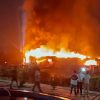Goa is abuzz with excitement as vintage bike and car owners, users, collectors and fans are decking […]

DECIPHERING THE FINE PRINT!
Budget 2021, Feb 06- Feb 12, 2021 February 5, 2021IGNORED: The budget has nothing to offer to several lakh migrant contract labor, who lost jobs following the Covid-19 lockdowns. They not only lost their jobs but also the humble rented accomodation for which they could not pay rent to local landlords and landladies.
By Special Correspondent
Budget fine print reveals that it is a capitalist oriented budget and does not have anything to offer 30% of the country’s population which makes up the bottom of the economic pyramid. Cost of living is bound to go up again to increase GST on pulses, edible oils and other essential commodities of mass consumption….
DID the 2021 Budget bring good cheer to the common man laboring under the uncertainty wrought by the corona virus? Was this year’s budget something that the common man could be happy about?
While many of the mainline newspapers dependent upon governmental largess were quick to praise the budget, a close look at the fine print shows that this is a capital oriented budget that caters to capitalists in the country; but gives nothing to the 30% of the population at the bottom of pyramid, neither those who have lost their jobs in the recent Covid-19 crises, nor to the semi-skilled migrants who have not yet returned to their former urban centers since there are no work.
In this year of economic crisis Finance Minister Nirmala Sitharaman did not address the major concerns of the most vulnerable sections of the Indian society. In line with the current ideology of the government, this was a capitalistic budget, with plans for massive spending in the hope that this will create jobs, infrastructure and then spur the economy.
The focus of the budget was humongous spending. For the FM believes that this will accelerate the “green shoots” that the lock-down economy has generated in the last few months. For Covid-19 lockdowns shut the country from end-March till June-2020, well ensuring that the economy came to a standstill. While many economists talk of green shoots that they believe are portent signs of recovery, the stark reality is that the economy has yet to really pick up – despite the stimulus that the government has attempted to give the economy.
At the macro level Finance Minister Nirmala Sitharaman’s second budget does not have a big picture of the field reality that exists in this post- Covid-19 phase. Therefore, to that extent it is a lack-lustre budget, good in parts but lacking the vision to be able to look beyond the current predicament that India is placed.
In line with the ideology of the government, the budget has focused on big ticket spending — the major focus being on health and infrastructure. The health budget has been pegged at 2, 23,846 crore, a rise of 137% as against last year. The Prime Minister’s Atmanirbhar Swasth Bharath Yojana will be launched with an outlay of64,000 crore to strengthen health infrastructure. An additional vaccine fund has been budgeted at 35,000 crore. Would this spending on health infrastructure and the additional vaccine fund alleviate the health issues of the poor? There is no answer!
With the Punjab farmers sitting in protest at the doors of Delhi, the Finance Minister was quick to highlight the incentives being given to the agriculture sector. The minimum support price is pegged at 1.5 times the cost of production of all commodities. The target for agricultural credit has been raised to Rs16.5 lakh crore. Allocation to rural infrastructure has been increased to40,000 crore in the next fiscal as compared to 30,000 crore in the current fiscal. More than 1,000 mandis are to be integrated to an electronic national market to ensure that the prices obtain a better price realization. Unfortunately, there is nothing for the Punjab farmers protesting, except for empty promises.
ONE of the disturbing trends of the budget is the fiscal deficit that has risen to 9.5% of the gross domestic product in the financial year 2021-22. The Finance Minister hopes to bring this fiscal deficit to 6.8% in the next year. Where will the money come from for this big spending that is envisaged ? The finance minister hopes to borrow another80,000 crore from the market. What is the implication of this huge fiscal deficit? In the short term – prices of commodities will rise, with money in the system than the supply of goods and commodities.
Thus, in the near term the country will see a rise in inflation which is already at more than 5%. As is often seen, inflation hits the poor the most. For often inflation is seen at the field level in the rise of the prices of essential commodities. The growth of the fiscal deficit has not been commented much by the national press. With such a large fiscal deficit, worsened by poor revenue collections, where would the money for the governmental schemes come from?
Unfortunately, there is little debate on these issues.
Middle Class Blues
MUCH to the disappointment of the middle classes, there is no changes in the rates of income tax, nor the exemption limit raised. However, there are a few minor changes. Persons above the age of 75 years having only pension and interest income, will no longer be required to file their tax returns. The tax will be deducted at source by those who make payment of these pensions and interest. However, those senior citizens getting rental income or professional or business income or capital gains would still be required to file their tax returns. Keeping of old records for the purpose of the reopening of assessments for a period of six years is cumbersome. The period has now been reduced to three years with the caveat if the evasion is more than 50 lakhs, the period of reopening would still be ten years.
The Tax department has experimented with faceless assessments as also faceless appeals. This procedure is now being extended to a faceless tribunal appeal. The problems associated with faceless assessments and faceless appeals have still not been examined. It is not known how this faceless tribunal appeals would pan out; especially in cases where the Tribunal being the last fact-finding authority would have to examine certain aspects in detail. For those wishing to avail of a loan to purchase a new house, there is an additional deduction of interest of1.5 lakhs in addition to the deduction already available; this facility is now extended for one year more. The limit for tax audit has been now doubled to Rs10 crore for companies doing business through the digital mode.
Cooperative Banking, An Opportunity to Become a Small Finance Bank
GOA has several cooperative banks that are on the verge of closure, thanks to the growing non- productive asset (NPA) position. Several of these banks have already shut. This budget gives these banks a lifeline. A cooperative bank would not be liable to capital gains tax, should it decide to convert itself into a small finance bank. Probably some of the cooperative banks in Goa would be able to use this route to remain in business.
What has become cheaper?
GOANS will be happy to learn that the customs duty on both gold and silver has been reduced to its earlier rate of 10% customs duty. This will reduce the price of gold especially now that the marriage season is drawing near. Similarly, household article such as vessels would also become marginally cheaper with the reduction in tax on stainless steel to 7.5%.
What will cost more?
ARE you the one for a fancy phone? Well, parts that go to make up a phone, like circuit boards, camera modules and connectors, customs duty will now be 2.5% as against the earlier nil duty. So also, lithium cells will now attract a duty of 2.5%. LED lights and fixtures solar inverters and solar lamps that are common in Goa will now come with enhanced duty. Your fridges and air- conditioners will also cost you more with a hike of 2.5% in the duty being levied on them.
Goans would also be benefitted with the voluntary vehicle scrapping policy where old and unit vehicles would be scrapped. As per the statement made by the FM, private vehicles would have to undergo a fitness test after 20 years from the date of registration while for commercial vehicles it will be 15 years. This will certainly ensure that many of the older vehicles will no longer remain on Goan roads.
A gift to GOA
GOA did get special mention. On the diamond anniversary of the accession of the State of Goa to the Union, an amount of `300 crores have been allocated for this celebration? Where will this money go? How will the government use this money? It is said, never look a gift horse in the mouth. Or is this a gift to ensure that the people of Goa bring back the ruling political dispensation in March 2022!















